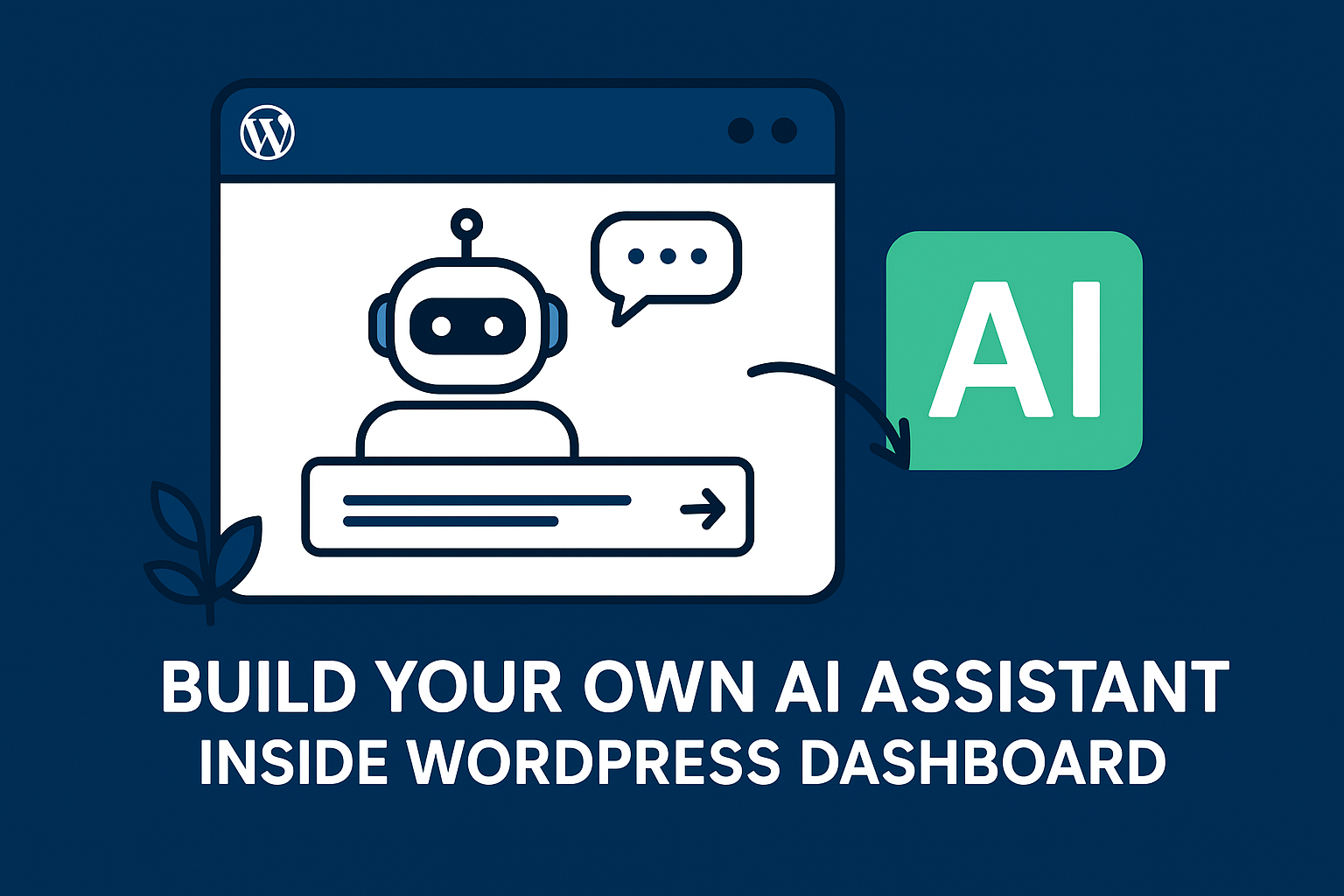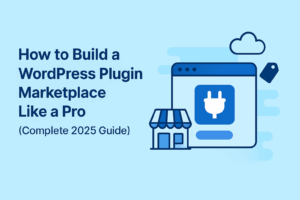
Build Your Own AI Assistant Inside WordPress Dashboard
Introduction
Adding an AI assistant directly into the WordPress dashboard gives authors, editors and admins immediate help: content generation, summaries, SEO suggestions, ticket triage, code hints, and more. This guide shows you how to design, build, and ship a secure in-dashboard AI assistant in 2025 — with architecture options, example code (PHP + JavaScript), privacy considerations, and production checklist.
🏗️ 1 — What the assistant can do (core features)
- Write & rewrite: generate blog drafts, improve readability, localize text.
- Summaries: summarize long posts, comments, or support threads.
- SEO & readability suggestions: title suggestions, meta descriptions, focus keyphrase variants.
- Code snippets & explanations: helper for shortcode examples, theme snippets, plugin code.
- Admin tasks: generate changelogs, draft commit messages, triage support tickets.
- Conversational UI: chat with the assistant about the site (with scope-limited knowledge).
🧭 2 — Architecture & model choices
Two main architecture patterns depending on privacy, cost and latency:
A — Hosted API (recommended for speed & flexibility)
- Frontend (WP Admin) → Backend plugin REST endpoint → AI vendor API (e.g., cloud model)
- Pros: fast to build, access to large, up-to-date models; Cons: external data leaves site (watch privacy).
B — On-premises or edge models (privacy-first)
- Host a local model (Quantized LLM, private API) inside your infra or on the same cloud region. Plugin calls local inference server.
- Pros: better data control and compliance; Cons: higher ops cost and hardware requirements.
Hybrid option: perform light tasks locally (summaries, regex) and heavy LLM calls via hosted API with anonymization.
🔌 3 — Data flow & security model
Design rules:
- Never send raw user passwords or secret keys in prompts.
- Anonymize or remove PII before sending content to external models.
- Use HTTPS, server-side API keys (do not store model API keys in JS).
- Throttle requests and add per-user rate limits.
- Log actions with pointer IDs (not content) and store user consent records.
🛠️ 4 — Example: Minimal plugin scaffold (PHP)
Below is a minimal WordPress plugin skeleton that registers a REST endpoint and enqueues a simple admin app.
// wp-content/plugins/wp-ai-assistant/wp-ai-assistant.php
';
}
add_action('admin_enqueue_scripts', function($hook){
if ( $hook !== 'toplevel_page_wp-ai-assistant' ) return;
wp_enqueue_script('wp-ai-assistant-app', plugin_dir_url(__FILE__) . 'assets/app.js', ['wp-element'], '0.1', true);
wp_localize_script('wp-ai-assistant-app', 'WP_AI', [
'restUrl' => esc_url_raw( rest_url('wp-ai/v1/ask') ),
'nonce' => wp_create_nonce('wp_rest')
]);
});
add_action('rest_api_init', function(){
register_rest_route('wp-ai/v1', '/ask', [
'methods' => 'POST',
'callback' => 'wp_ai_handle_ask',
'permission_callback' => function(){ return current_user_can('edit_posts'); }
]);
});
function wp_ai_handle_ask( WP_REST_Request $req ){
$body = $req->get_json_params();
$prompt = sanitize_text_field( $body['prompt'] ?? '' );
if ( empty($prompt) ) {
return new WP_REST_Response(['error'=>'Empty prompt'], 400);
}
// Example: call internal helper to query model (replace with real implementation)
$response_text = wp_ai_query_model( $prompt, get_current_user_id() );
return new WP_REST_Response(['answer'=> $response_text]);
}
function wp_ai_query_model( $prompt, $user_id ){
// IMPORTANT: Implement proper model integration here.
// Example pseudo-call: send prompt to your backend service that holds API keys.
// For demo return a static text:
return "This is a demo response for prompt: " . wp_trim_words($prompt, 40);
}
🧩 5 — Example: Simple React/Vanilla chat UI (assets/app.js)
// assets/app.js (built for simplicity; in production, use React+Webpack or @wordpress/scripts)
(function(){
const root = document.getElementById('wp-ai-assistant-root');
root.innerHTML = `
`;
document.getElementById('ai-send').addEventListener('click', async () => {
const prompt = document.getElementById('ai-prompt').value;
document.getElementById('ai-answer').textContent = 'Working…';
const res = await fetch(WP_AI.restUrl, {
method: 'POST',
headers: {
'Content-Type': 'application/json',
'X-WP-Nonce': WP_AI.nonce
},
body: JSON.stringify({prompt})
});
const json = await res.json();
document.getElementById('ai-answer').textContent = json.answer || (json.error || 'No response');
});
})();
⚙️ 6 — Model integration patterns (practical tips)
- Prompt templates: keep templates server-side; supply only variables from the client.
- System & user separation: craft a system message that instructs the model about tone, privacy and forbidden operations.
- Few-shot examples: for consistency provide 1–3 examples to the model (capped for cost).
- Safety filters: run simple content filters (bad-words, PII regex) before sending prompts and before saving outputs.
🔐 7 — Privacy, logging & compliance
Be explicit about what you store and why:
- Record user consent on first use — show a short modal explaining that content may be sent to an AI provider (if external).
- Allow users (or site owners) to opt-out of sending content externally.
- Keep minimal logs: store prompt metadata (length, timestamps, user ID) but avoid storing full prompt/response unless necessary — and encrypt when stored.
- Offer a policy page describing retention, deletion, and third-party providers.
🧪 8 — Testing, UX & fallback behavior
- Show progress indicators and timeouts; avoid freezing the UI on long model calls.
- Provide a fallback text if the model fails (cached suggestions or canned templates).
- Test with different user roles — editors, authors, admins — and ensure permissions are respected.
- Include an “explain output” button so users can ask the assistant to justify its suggestion (useful for editorial trust).
💸 9 — Cost control & rate limiting
LLM API calls can be expensive — implement:
- Per-user or per-site monthly quotas (configurable in plugin settings).
- Batch frequently used tasks (e.g., generate 3 meta descriptions at once) to reduce calls.
- Cache common responses for templates/prompts (Redis / transient API).
🧾 10 — Advanced features & product ideas
- Site-aware assistant: index site content (posts, docs) and provide answers grounded in that content (embedding + semantic search).
- Automated PRs: generate patch suggestions for theme/plugin repos (GitHub integration).
- Multi-lingual support: auto-translate drafts and provide locale-aware suggestions.
- Role-aware suggestions: admins get security suggestions; authors get SEO/content ideas.
- Paid tier: higher-rate limits, team usage analytics, private models.
✅ 11 — Deployment & production checklist
- Hide all model API keys on the server (never in client JS).
- Implement CSRF protection and permission checks for REST endpoints.
- Set per-minute and per-day caps; implement exponential backoff on failures.
- Provide clear privacy & data processing docs and collect consent.
- Add logs and monitoring for API error rates and latency.
- Perform load testing with expected concurrency and cold-start scenarios.
- Prepare a fallback UX for model outages (cached templates, offline mode).
🔮 Conclusion
Embedding an AI assistant inside the WordPress dashboard can supercharge your editorial workflow, support team, and developers — but it requires careful choices around architecture, privacy, cost control and UX. Start small with a safe MVP: server-side prompt templates, secure REST endpoints, and simple chat UI. Iterate by adding site-aware features, caching, quotas and robust observability.
If you want, I can also:
- Generate a ready-to-install plugin ZIP with the minimal scaffold above.
- Provide a production-ready example that calls a real LLM (with placeholder for your API key).
- Create a featured image in the Plugintify style for this article.
Published by Plugintify — The Hub for WordPress Plugin Developers.




